
Proof and Evidences of ramayana in sri lanka
Right from Alexander to Akbar-the great, all the mighty ruler of this world wished to rule India-the richest nation of this planet. Till the sixteenth century, India contributed 33% of the world GDP. In the late seventeenth century, India got invaded by cruel British whose only aim was to loot India wealth. To stop the Indians from protesting against British rule, they decided to divide the unity of India by creating false history of India. They hired some south Indians authors and wrote various theories (like Aryan invasion theory) to justify their rule in India. It is very surprising, and at the same time, very sad that most of the Indians believe in the history written by our enemies (British authors) who had nil knowledge of Sanskrit, zero perception power, no respect for Ramayana and Mahabharata, and were only interested in ruling India by their divide and rule policy. Their strategic attack on Indian civilization paved the path of western materialistic culture in India. Science of Vedic India, ignored by British authors, is today admired by most of the scientists of this world. Today, more than Indians, westerner’s admired Indian culture and are fascinated in knowing the true history of ancient India. After the recent findings like that of saraswati civilization and ram setu, most of the ancient myths of Ramayana and Mahabharata are found to be glorious history of ancient India. Today, we will see one of such proof of Ramayana in sri lanka. This article is based on the interviews with sri lankan historians, museum authorities, local citizen, archeologists and anthropologists of sri lanka.
What Sri lankans think about Ramayana?
Sri Lankan Tourism is aggressively selling the Ramayan Events to attract thousands of visitors and pilgrims from over the world, especially from India. According to Kalaiselvan, director of Sri Lanka Tourism, “Sri Lankan historian, archeologists and religious scholars have found more than 40 places associated with sacred epic Ramayana. Despite of being a Buddhist-majority country, locals at this place regard these historical characters with great respect, have left these places untouched and are very proud of the association of their places with Indian epic Ramayana" said S Kalaiselvam, director-general of Sri Lanka Tourism. He also added "Ramayan is an epic that binds India and sri lanka. We believe Ramayana has brought us together and it is our responsibility to restore and maintain these religious sites of great significance”.
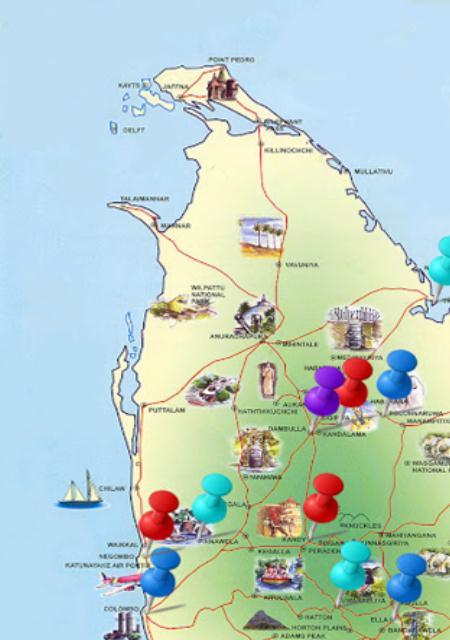
Ramayana sites in sri lanka
Ravana- king of the whole world lived in lanka
Since ravana was the king of sri lanka and 9 other kingdoms, he was known as ‘Dasa Shirsha’, meaning 10 heads. The logic behind this title was that he had ten crowns on his head, one for each kingdom. Sri lanka was the great nation of four clans- Naga, Devas, Yaksha and Gandharva, who worshipped sun god and were unified together as ‘Sivhala’ by king Ravana. Since Ravana was the great devotee of lord shiva, he might have chosen the name Sivhala meaning “Devotees of lord Shiva”. Over the time, Sivhala became Sinhala and lord shiva devotees became lord Buddha devotees. In the eastern district of Trincomalee is the Koneswaram temple, gifted by Lord Shiva to Ravana. This temple is unique where the lord has built a temple for his devotee as a reward of his devotion.
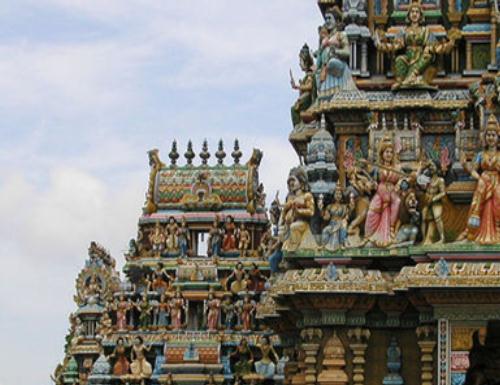
Koneshwaram temple
In the same district of Trincomalee, at a place called Vilundri, lord rama stopped on his return journey to pay respect to lord shiva so as to get rid of Brahmahasthi Dosham(more in later section). Since he rested his bow on the ground here, this place is known as Vilundri. In Tamil, Vil means ‘Bow’ and ‘Undri’ means “to rest”. Ravana flag depicting the moon and sun is the oldest flag of Sri Lanka. Ravana first built a temple for their beloved parents Visravasmuni and Kesini at Anuradhapura, first capital of sri lanka. This temple is today called “Isurumuniya”.
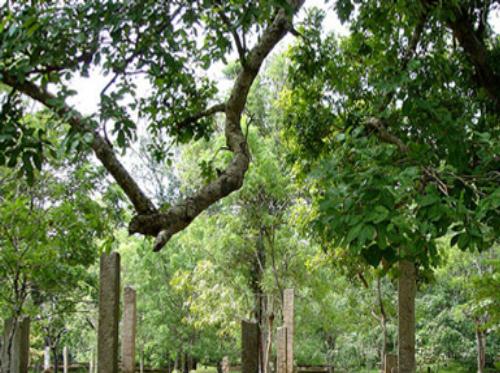
Ruins of Anuradhapura
According to archaeologists, sri lankan architecture across these places are very similar to Indus-saraswati civilization. Sigiriya, one of the world famous pre-historic antique monuments is believed to be the Alakamanda Palace of King Kubera, later captured by step brother Ravana. Beautiful murals of Yaksha, Naga, Deva and Gandabbha damsels with beautiful flowers in their hands are depicted on walls of ravana palace. Sigiriya was built by talented architect Maya Dannawa, under the order of king Visravasmuni.
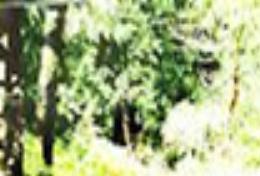
Ruins of sita kotuwa
Carefully carved rocks can be seen at Seeta Kotuwa, about three miles from Hasalaka on the Kandy-Mahiyangana road. Ravana aircraft repair centre was at Gurulupotha, very close to Sita Kotuwa. Gurulupotha in sinhala means ‘Parts of Birds’. Ussangoda, Wariyapola and Kurunegala were the three places where the flying chariots of ravana landed and took off.
Sita taken from ‘Sita Kotuwa’ to ‘Ashok Vatika’
To enchant sita, ravana thought of showing the beauty of his kingdom. Sita was taken across the Mahaveli ganga to ashok vatika, the most beautiful garden surrounded by salubrious mountains and forests with soothing sound of air and streams. The path from sita kotuwa to ashok vatika is still visible from these mountains. Present Hakgala Gardens is the part of ramayana Ashok vatika. An arid area on top of Hakgala Jungle is called as sita pokuna, meaning ‘place Sita was held captive.’
Sita’s captivity at Ashok Vatika (also known Asoka Vanam)
Ashok vatika is near to present Sita Eliya, which is very close to present city of Nuwara Eliya.
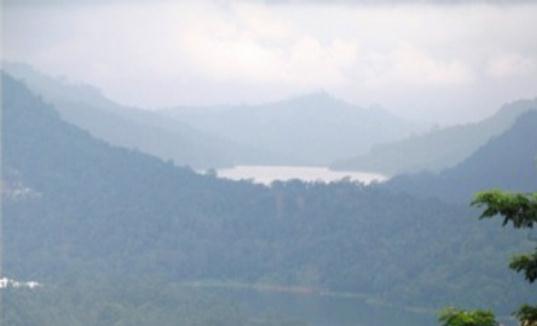
Mountain of Nuwara Eliya(Ashoka vatika)
Adjoining the path, there is a pond named ‘sita eliya’ that descends from the mountains. It is believed that sita took bath in this pond. This pond, about 15 meters wide, is said to be formed by tears of sita. On one side of the pond, there is a flat rock with an imprint of mighty foot on it. It is believed lord hanuman landed on this rock in the form of a gaint.
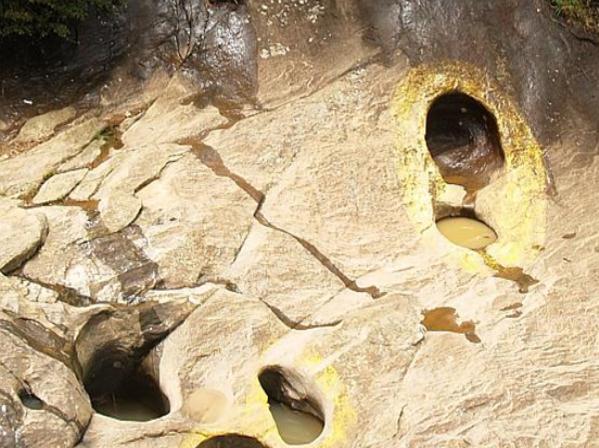
Giant footprints of lord hanuman
His pond passes through the tunnel which is believed to be the hiding place of sita when ravana rode on elephant in search of sita.
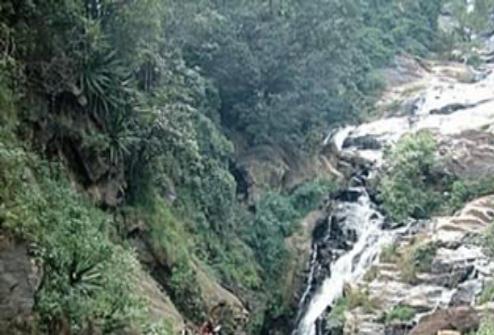
Stream of sita eliya
Next to this pond is sita amman temple, named after sita.
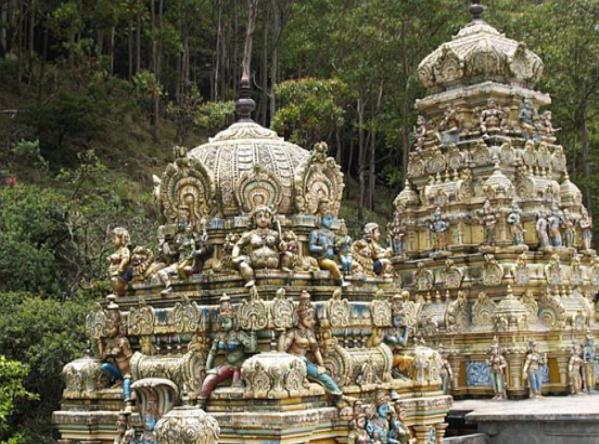
Closer look at Sita Amman Temple
There is also a village named Kondagala, where Sita is believed to have deranged her hair. In this village, there is one place called Sita Gooli, named after the incident of sita throwing away rice balls offered by Ravana. Local villagers who got this rice balls from their ancestors, keep it in their baskets and boxes as a belief that this would bring happiness and prosperity in their life. Additionally, tourists are often amazed to see flowers in this mountain range named after sita.
Search for Sita in Indian Ocean
In the lord rama conquest of searching sita, hanuman was guided by jambavan to cross Indian ocean in their task of searching sita in sri lanka. While travelling through the ocean, he was tested by demon Surasa Devi. This place in the ocean is today known as nagadeepa. Also there is a place named Hanumantota, where Chinese are building their first naval ship. At Ramboda in the central highland, is the temple of lord hanuman as he had visited sita at this place. Next to the mountain range overlooking Frotoft Estate, this is the place where lord hanuman first landed in sri lanka. 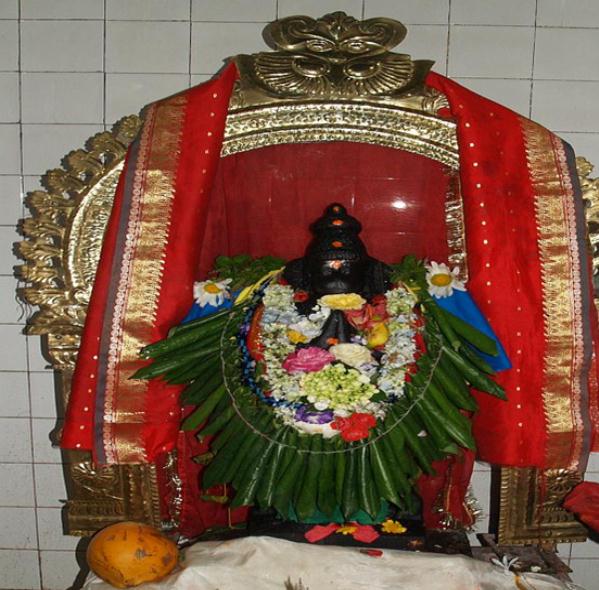
Hanuman temple or Anjaneya temple, the only temple to have a chariot for Anjaneyar. Hanuman's mother name is Anjana. So, Hanuman is also known as known as Anjaneyar(Anjan +Aiyar ).
Hanuman meets Sita at Ashok Vatika and is captured by R āvana
After meeting Sita at Ashok Vatika, hanuman uprooted some of the trees to quench his hunger. Humiliated by hanuman actions, ravana ordered his soldiers to punish him by burning his tail but his punishment turned out to be fugitive as he saw his entire city burnt down by hanuman. Present Ussangoda was the part of city burnt down by hanuman. Astonishingly, the color of soil across hundreds of acres of land is black, in total contrast to light brown fertile soil in the adjacent areas.
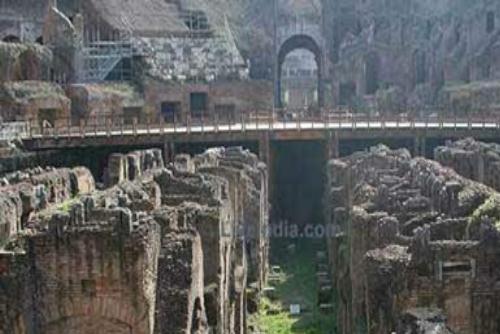
The Ravana Palace, burnt down by Hanuman
Sita is hidden after the visit of Hanuman
Seeing the strength and capabilities oh hanuman, ravana decided to move sita to some other secret place. Râvanagoda, an area of complex caves and tunnel is the area where sita devi was kept hidden in secrecy. Istreepura, meaning ‘area of women’ in Sinhalese, is another place full of ingenious network of paths interconnected to all prime areas of Râvana capital city Lankapura. Istreepura refers to lady servants chosen by ravana to look after Sita.
Places of battle in sri lanka
Ravana most powerful son meghnath, also known as indrajit was granted celestial supernatural power by lord shiva at Gayathri Peedum. The place where lord rama shot an arrow to produce water from ground for his army is known as Neelawari, a beautiful place located in the Jaffna peninsula. Dondra, Hikkaduwa and Seenigama are the places south to lanka from where Sugriva battled against armies of king ravana. In Wasgamuwa, there is a place named Yudhaganawa, meaning battlefield in Sinhalese. This is the place where the war between lord rama and ravana broke out. To break the fighting spirit of powerful hanuman, meghnath beheaded a replica of Sita Devi. It is believed that this incident happened at a place called as Sita waka of Avissawella district. Also, there is a footmark of lord rama at one of the stones in this area. Lord Karthikeya was sent by lord indra to help lord ram against Râvana Brahmastra. This happened at Kataragama, a sacred place of worship among Sri Lankans.
Hanuman- the greatest devotee of all times, bring mountain on his hand
Upon being hit by the most powerful celestial weapon ‘Brahmastra’, lakhshman was unconscious and dying in the battlefield. Hanuman was instructed to bring the herbs from Sanjeevani Mountains of the Himalayas. As hanuman was not able to identify the herbs, he uprooted the whole mountain and started travelling lifting the mountain on his bare hand. While travelling in sri lanka, parts of this mountain fell in the areas of Katchchathivu, Dolukanda in Hiripitiya, Talladi in Mannar, Unawatuna in Galle, Ritigala in Habarana. All this areas are rich in ayurvedic medicinal herbs and plants. Unawatuna of Galle means ‘here it fell’. Indeed, the area is known for its medicinal plants. About 150 km north of Colombo, there is a mountain near Ruma Sulla, surrounded by ocean and sandy beaches. At first look, everyone kinda gets a feeling that this mountain came from some another place. This mountain is rich in ayurvedic herbs and medicinal herbs with soil unmatched with soil in all areas of sri lanka.
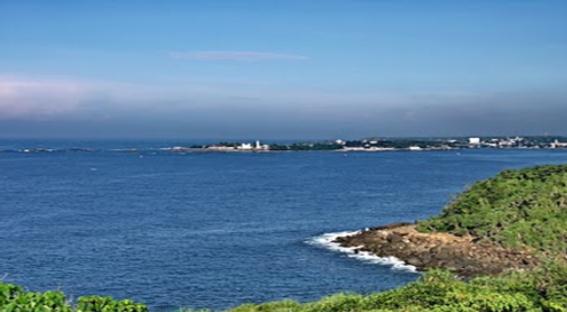
Ruma Sulla, mountain surrounded by ocean and sandy beaches
Rama kills Ravana at Dunuwila
Dunuwila is the location from where lord rama fired his brahmastra at king Râvana. Ravana was managing his troops from Laggala, the place where he fell down to rama brahmastra. Laggala is obtained from the Sinhalese phrase “Elakke Gala”, meaning Target Rock. Since Laggala was the highest point in the northern part of ravana city, he chose this place to keep an eye on Lord Rama’s army. After Râvana’s death, his body was kept at Yahangala or Divan (meaning bed rock), so that his countrymen can offer their last respect to their valiant king.
After the devastating war, Lord Rama, Lakshmana, Hanuman and their armies rested at a place named Vantharamulai. They had their first meal at the place named Amaranthakali.
Coronation of vibhisana and agni-pariksha of sita
After king Râvana’s death, Râvana’s brother Vibhishana was coroneted king of Lanka by Lakshman at Kelaniya. In the famous Buddha Vihara at Kelaniya, there is a painting of lord rama handing over the reign of Sri Lanka to Ravana’s brother, Vibhishana. After coming to power, Vibhisan transferred his capital from the hill country to Kelaniya and ravana palace was overtaken by Yaksha king ‘Chithraraja’, the hero who befriended King Pandukabhya. Son of King Pandukabhya named this place as Chitrakuta. According to local Archaeologists and historians, there are more than 500 mural paintings on wall of Chitrakuta, most of which are dilapidated because of natural calamities. Valahassa Jathika, an ancient Buddhist scripture as mention of Kelaniya as the centre of Naga civilization. Both tamil hindus and Sinhalese Buddhist offer their prayer to king Vibhisan, believed to be the guardian deity of south west sri lanka.
Sita passes Agni test
Before accepting sita, rama asked her to undergo an agni(Fire) test to testify her innocence and sexual purity. Divurumpola, meaning ‘place of oath’, is the place where she underwent her “Agni” test. At this place, there is a banyan tree called Deewurugaha (swearing tree) where sita walked through the fire to complete his agni test.
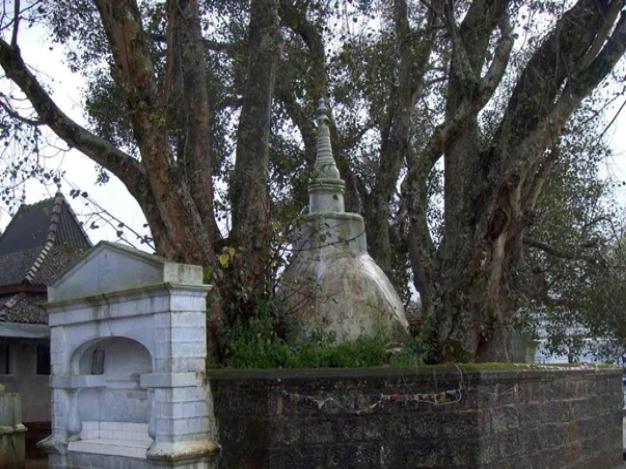
Banyan tree ‘Deewurugaha’ of Divurumpola
Even today, local villagers settles their disputes and claims beneath this tree with oath taken on goddess sita.
Rama undergoes penance for killing a Brahmin
Ravana was known as a demon but in reality, he was a Brahmin, grandson of sage Pulatsya (Pulatsya is one of the eight mind born son of lord brahma, progenitor of naga, yaksha and gandharva). There are few verses in rigveda exemplifying the divine status of sage pulatsya. There is a magnificent statue of sage pulatsya in Polonnaruwa. Statue is shown carrying a large fish on his hands, probably exemplifying his relationship with Sarasvati civilization.
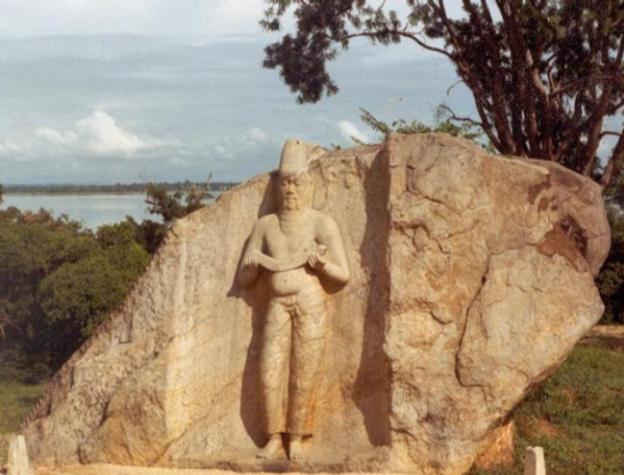
Statue of sage pulatsya
Since Rama felt guilty of killing a Brahmin (Brahmahasthi Dosham), he decided to take penance at Munneswaram, 80 km from present Capital city colombo. This is the place where lord Rama prayed to lord Shiva and lord Shiva answered his prayer by asking him to install four lingams to get expiated of sin of Brahmahatya (killing of a Brahmin). At an auspicious time, four lingams were installed by lord ram at Thiru Ketheshwaram, Manavari, Thiru Koheneshwaram, and Rameshwaram in India. Rameshwaram is the sacred site for both Vaishnavites and Shaivities and no pilgrimage is complete without visiting this town. Out of this four, one of the linga was made of sand by sita and other brought by lord hanuman from Kailas Mountain. Lingams at rameshwaram and manavari temple was built by lord rama himself and so, is known as Ramalingam
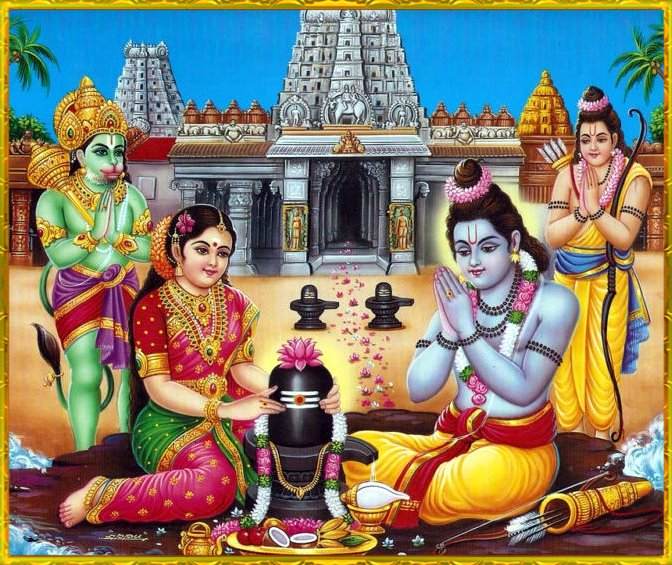
Lord Ram. Goddess Sita, brother lakshman and hanuman praying to one of the installed lingam
Return journey of lord ram with sita and whole army was on the same route as taken by them earlier. From Lanka, they flew on Pushpak Viman to Trikuta Mountain. After crossing the ocean, they arrive at Hiranyanabha Mountain. From there, they flew over Mahendragiri, Velavna, Kishkinda, Rasyamkha, Pampa, Janastana, Godavari, Pasravangiri, Agatsyasrama, Sarabhangasrama, Atri’s Ashrama, Chitrakuta, Mandakini, Yamuna, Valmiki Ashrama and rested at Bharadvaja hermitage. From here, they sent the message of arrival to Bharat through hanuman and then reached ayodhya after crossing the river Ganga and Sringaverpura.
Conclusion:
Despite of hundreds of sacred sites of Ramayana in India and sri lanka, Ramayana is still shown as a myth by many historians across the world. Devotees are not bothered by the false history written of such historians and they continue to believe in the large body of traditions and cultural values that have originated and survived over hundred centuries in india and sri lanka.
Note: Images used on this website
are either a production of Bhaktivedanta Book Trust(https://www.krishna.com), Iskcon
Foundation or were found in google search under "Free to use and share". If any
of the images presented here violates copyright issues or infringes anyone copyright
or are not under "Fair use", then please bring it to our notice. Read
Disclaimer for more.
Share this to your friends. One of your friend is
waiting for your share.
Related Articles
Hinduism Symbol Swastika in american churches and universities
Avatar Movie similarities with Ramayana and hinduism
Science in Hinduism-Cloning humans
Hanuman Chalisa english poetic translation-Part 2
Science in Hinduism-Large numbers and infinity
Proof and Evidences of ramayana in sri lanka
Birth of lord Rama- Ram Navami
Hanuman chalisa English poetic translation with Hindi subtitles
Hanuman Chalisa english poetic translation-1
Why lord Rama is called Maryada-Epitome of truth and discipline
Post Comment